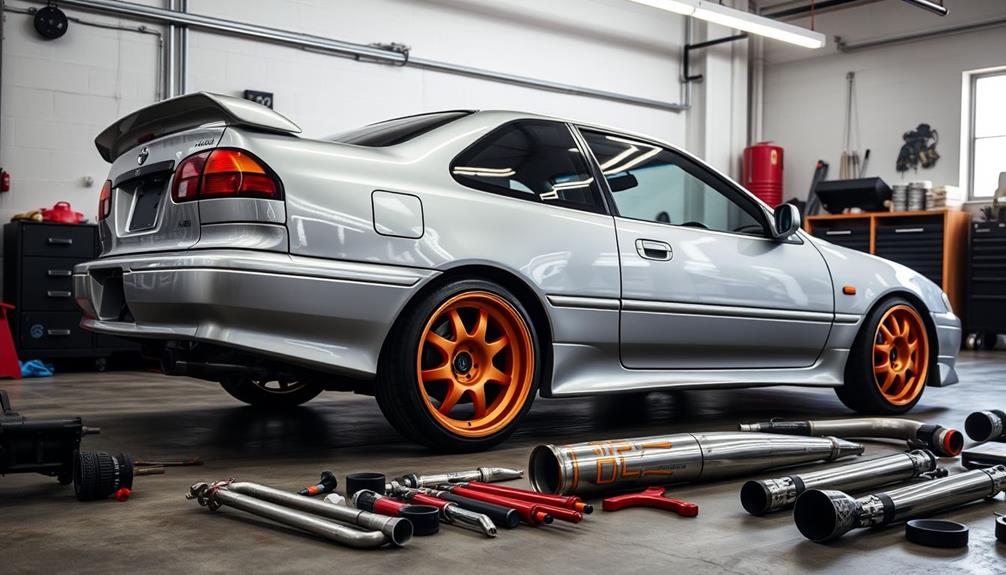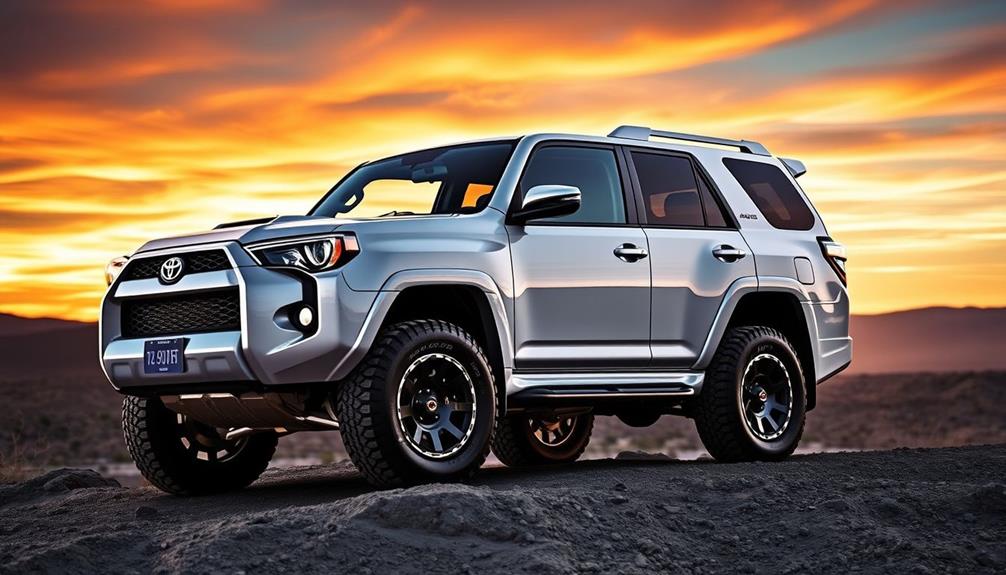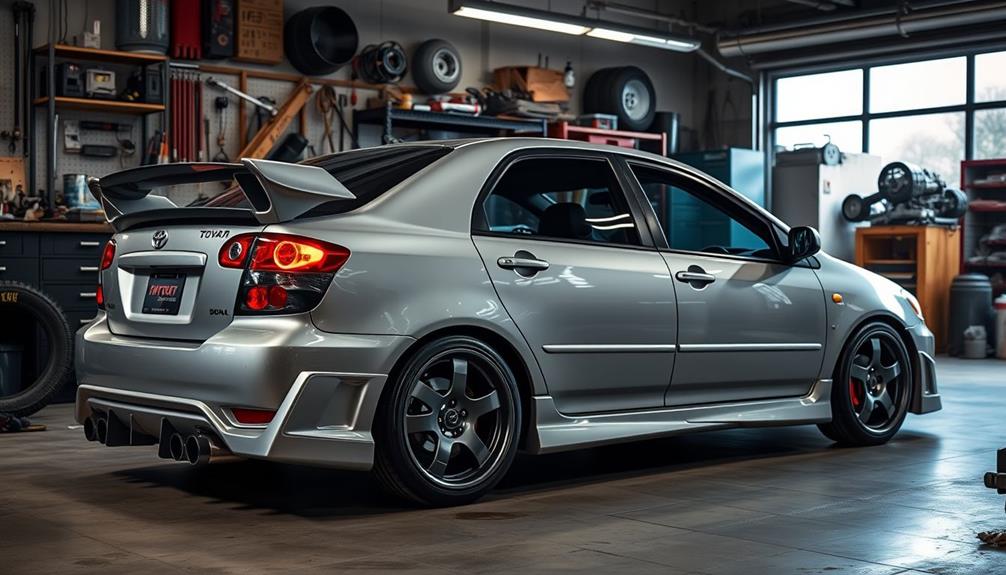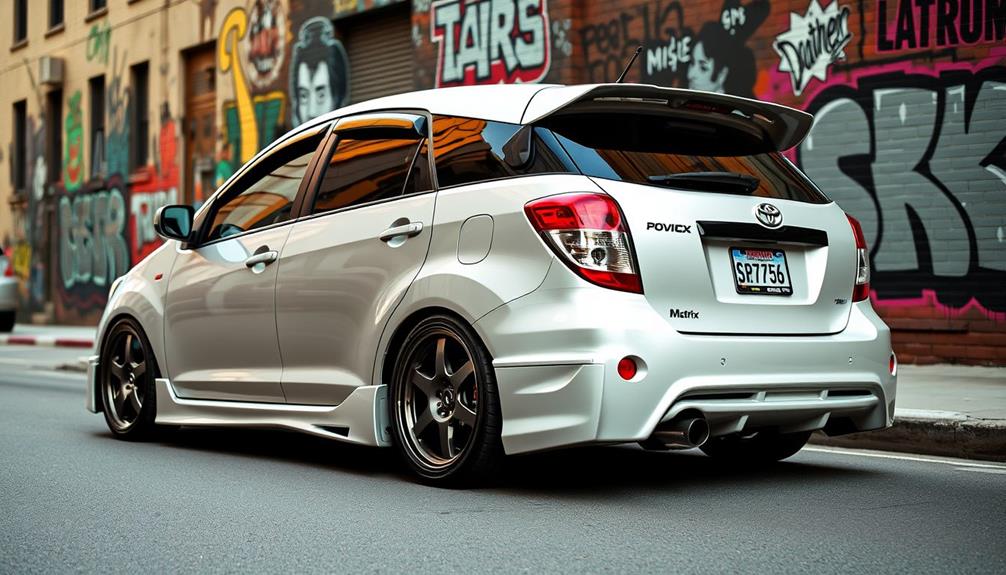Tuning your 1995 Toyota Corolla can boost its performance while keeping that classic charm. Start with an engine swap for immediate power gains—options like the JDM 4AGE or even the Camry V6 can transform your ride. Consider adding a turbocharger; it enhances efficiency and maximizes output without extensive mods. For simpler upgrades, install a cold air intake and an aftermarket exhaust system to improve airflow and sound. Don't forget to check online forums for tips and community insights. As you explore these options, you'll discover even more ways to make your Corolla truly stand out.
Key Takeaways
- Consider engine swap options like the JDM 4AGE for reliable power enhancements or the Camry V6 for substantial horsepower increases.
- Turbocharging offers significant power boosts and improved efficiency compared to naturally aspirated modifications, making it a cost-effective option.
- Upgrading with a cold air intake and performance exhaust system can enhance airflow and increase horsepower without major engine modifications.
- Regular maintenance, including oil changes and brake system upgrades, is crucial for sustaining performance post-modifications.
- Utilize community resources like online forums and project threads for insights and support from fellow Toyota enthusiasts during your tuning journey.
Engine Swap Options
When considering engine swap options for your 1995 Toyota Corolla, you'll find a range of choices that can greatly enhance performance. The JDM 4AGE Silvertop or Blacktop engines are top recommendations, celebrated for their reliability and impressive power enhancements. These engines fit well in your engine bay, making installation a more straightforward task.
If you're looking for a more substantial horsepower increase, consider swapping in a Camry V6. This option packs a serious punch and transforms your Corolla into a powerhouse.
However, if you're still contemplating the older SR5 engine, be cautious; while it fits, it's not cost-effective due to limited performance upgrades.
The 7A-FE engine offers a stock option with just over 100 horsepower, but it lacks the upgrade potential that tuning enthusiasts crave.
If you're aiming for high performance and don't mind tackling a more complicated installation, the 2JZ swap is an exciting choice, though it requires more effort to integrate into your engine bay.
Ultimately, your choice will depend on your performance goals and how much work you're willing to put into the swap.
Turbocharging Vs. Naturally Aspirated

When considering performance upgrades for your 1995 Toyota Corolla, you'll want to weigh the benefits of turbocharging against the limitations of naturally aspirated engines.
Turbocharging can boost your horsepower considerably without the extensive modifications that naturally aspirated setups often require.
Plus, with proper tuning, a turbocharged engine can offer both power and fuel efficiency, making it a compelling choice.
Turbocharger Advantages
Turbocharging offers clear advantages over naturally aspirated engines, especially when it comes to performance gains. If you're looking to enhance your 1995 Toyota Corolla, installing a turbo kit can considerably boost your horsepower and torque, often providing power gains of 100+ HP with low-boost setups.
Here are some key benefits:
- Increased Power: Turbocharging maximizes engine output without the need for extensive modifications.
- Improved Efficiency: A turbocharger forces more air into the combustion chamber, leading to better fuel combustion and overall performance.
- Cost-Effectiveness: Turbo systems often yield superior results for lower investments compared to the costly changes required for naturally aspirated engines.
- Simplicity: Installing a turbo kit is generally simpler than upgrading components like high-compression pistons or camshafts to match turbocharged performance levels.
However, it's essential to verify your engine is in good condition before considering a turbo kit.
While turbocharging can dramatically enhance your Corolla's performance, it can also expose any existing mechanical issues, so maintenance is key.
Embrace the turbocharging advantage for a thrilling driving experience!
Naturally Aspirated Limitations
While turbocharging your 1995 Toyota Corolla can lead to impressive performance gains, naturally aspirated engines have their own limitations that can hinder power potential. The stock 7A-FE engine, for instance, typically caps out at just over 100 horsepower without significant modifications. This limitation stems from the engine's reliance on atmospheric pressure for air intake, unlike turbocharged engines that can force in more air and fuel.
Here's a quick comparison of the two setups:
| Feature | Naturally Aspirated | Turbocharged |
|---|---|---|
| Power Potential | ~100 HP | 50-100+ HP increase |
| Cost of Upgrades | Higher for similar gains | Generally more cost-effective |
| Air Intake Method | Atmospheric Pressure | Forced Induction |
| Typical Modifications | Intake, throttle, exhaust | Turbo installation |
Upgrading components like the cold air intake or exhaust can improve naturally aspirated engines, but these tweaks still won't match the overall performance boost you can achieve with turbocharging. If you're aiming for serious power, weigh your options carefully!
Performance Enhancements

When it comes to boosting your 1995 Toyota Corolla's performance, consider starting with a cold air intake for an easy 7 HP gain.
Upgrading your exhaust system can further enhance power and sound, while engine tuning options can release even more potential.
These enhancements not only improve horsepower but also enhance your driving experience.
Cold Air Intake Benefits
Upgrading to a cold air intake for your 1995 Toyota Corolla can greatly enhance your driving experience. By allowing cooler, denser air to enter your engine, you'll notice several performance benefits that make your ride more enjoyable.
Here are some key advantages:
- Increased Horsepower: You can gain approximately 7 HP without needing additional tuning, making your Corolla feel livelier.
- Improved Torque: The more efficient combustion from the cold air intake leads to better torque, giving you a stronger pull when accelerating.
- Enhanced Throttle Response: You'll experience quicker throttle response, making your driving more engaging and fun, especially during spirited drives.
- Sporty Sound: A cold air intake also adds a sporty growl to your engine, which many enthusiasts find appealing.
Many aftermarket options, like those from Injen, are designed to optimize airflow while maintaining the factory fit and sound levels.
This means you can enjoy improved performance without sacrificing comfort. Overall, a cold air intake is a popular choice among Corolla owners looking to boost their vehicle's performance and enhance their driving experience.
Exhaust System Upgrades
After enhancing your 1995 Toyota Corolla's performance with a cold air intake, the next logical step is to upgrade the exhaust system. Investing in exhaust system upgrades can greatly improve your car's performance and sound. A performance exhaust, like a Borla, enhances airflow while striking a balance between sound quality and horsepower gains.
You'll notice improved responsiveness as the engine breathes more freely. Consider installing aftermarket headers, which can boost your horsepower by over 21 and torque by 16 ft-lbs. This upgrade enhances engine efficiency and responsiveness.
A cat-back exhaust system is another popular choice among tuning enthusiasts, as it improves exhaust flow, reduces back pressure, and promotes better overall performance. Quality exhaust systems often feature mandrel bends that minimize turbulence, allowing for quicker exhaust gas exit.
When combined with your cold air intake, these exhaust system upgrades create a synergistic effect, optimizing engine breathing and combustion efficiency. This means you'll experience even greater improvements in horsepower and torque, making your Toyota Corolla not just a classic sedan, but a capable performer on the road.
Engine Tuning Options
Revealing your 1995 Toyota Corolla's true potential lies in exploring various engine tuning options. Upgrading your engine can greatly enhance performance, making your driving experience much more exciting.
Additionally, diversifying your investment in performance upgrades can help guarantee long-term satisfaction with your vehicle, much like how IRA rollovers can protect against inflation.
Here are some top options to reflect upon:
- Cold Air Intake: Enhancing airflow can improve combustion efficiency, potentially adding around 7 HP without needing a tune.
- AMT Tuning Box: This connects to your OBD2 and can deliver a Stage 1 tune with roughly 16 HP and 11 ft-lbs of torque.
- Performance Headers: These improve exhaust flow, offering gains of over 21 HP and 16 ft-lbs of torque from quality aftermarket options.
- Turbo Kits: For considerable power increases, turbo kits can exceed 100 HP, though they come at a price around $5,000, including necessary tuning modifications.
Each of these engine tuning options can transform your Corolla into a more powerful and responsive vehicle. Whether you’re looking to boost acceleration with performance exhaust systems or improve handling through suspension upgrades, there are numerous ways to enhance your driving experience. For those specifically seeking 2008 Toyota Corolla performance upgrades, options like cold air intakes or turbocharger kits can also provide significant horsepower gains. With the right combination of modifications, your Corolla can deliver a sportier and more exhilarating ride.
Whether you're looking for modest upgrades or a complete overhaul, there's something for every enthusiast. Embrace the tuning journey and enjoy the ride!
Community Resources

When you're diving into the world of tuning your 1995 Toyota Corolla, community resources can be invaluable. Online forums dedicated to Toyota Corolla modifications are treasure troves of shared experiences, advice, and troubleshooting tips from fellow enthusiasts.
These platforms make it easy to find answers to your questions and connect with others who share your passion.
Don't overlook Haynes manuals; they offer detailed insights into your Corolla's specifications and modifications, serving as a reliable reference for both DIY enthusiasts and mechanics.
Additionally, master sticky threads in Corolla forums often contain extensive guides on popular engine swaps and performance upgrades, helping you effectively navigate your tuning options.
Project threads from other Corolla owners can inspire you by showcasing real-life modifications and the results they've achieved.
These practical examples provide proven strategies for enhancing your car's performance.
Finally, networking with local and online Toyota enthusiast groups can lead to helpful recommendations for parts, services, and tuning techniques.
General Maintenance Tips

To keep your 1995 Toyota Corolla running smoothly, regular maintenance is key, especially if you've made performance modifications. Neglecting basic upkeep can compromise the benefits of your upgrades.
Here are some fundamental general maintenance tips to take into account:
- Oil Changes: Change your oil every 3,000 to 5,000 miles. This is essential for maintaining engine health, especially with performance mods that may strain the engine.
- Suspension Checks: Regularly inspect your struts and springs. This guarantees stability and handling performance after any upgrades that may increase power.
- Brake System Upgrades: Upgrade your brake components to match any horsepower enhancements. Periodic checks are crucial for safety and effective stopping power.
- Tire Maintenance: Invest in quality tires and check their condition and pressure monthly. This will enhance grip and handling, important for any modified vehicle.
Additionally, think about engine cleaning methods like seafoaming to improve combustion efficiency and maintain the throttle body.
Performance Parts Overview

Upgrading your 1995 Toyota Corolla with performance parts can transform your driving experience, giving it a much-needed boost in power and responsiveness. One of the first upgrades you should consider is a set of headers, which can provide over 21 HP and 16 ft-lbs of torque, greatly enhancing engine output.
Pairing this with a cold air intake kit improves airflow and combustion efficiency, adding around 7 HP without needing a tune.
Don't overlook the importance of an exhaust kit, like those from Borla. These not only enhance your car's sound but also improve exhaust flow, contributing to overall performance gains.
If you're looking for a more extensive upgrade, consider an engine management system. With pre-tuned modules, you can align power gains with your tuning needs, potentially adding up to 25 HP.
Lastly, throttle body spacers can yield an additional 12 HP and 14 ft-lbs of torque, enhancing throttle response in your classic sedan.
Installation Services

Installing performance parts in your 1995 Toyota Corolla can be a game-changer, and having the right installation services makes all the difference.
When you choose professional installation, you're ensuring that your upgrades are done correctly and efficiently.
Here's what you can expect from quality installation services:
- Expert Technicians: You'll work with specialists who've industry-recognized degrees and extensive experience in performance modifications.
- Up-to-Date Techniques: Continuous education keeps these technicians informed about the latest installation methods and technologies, ensuring exceptional service.
- Flexible Options: Installation services accommodate both customer-supplied parts and parts provided by the service center, catering to varying budgets and preferences.
- Quick Turnaround: With local warehouses and service centers, you'll enjoy prompt service without long wait times.
Cost Considerations

When you're considering performance upgrades for your 1995 Toyota Corolla, understanding the costs involved is essential.
Start with a cold air intake, which typically runs between $200 and $300. This upgrade can give you around 7 HP without needing a tune, making it a smart choice.
If you want to enhance both sound and flow, an exhaust system upgrade like the Borla can cost around $350 and improve overall performance.
For more serious upgrades, engine tuning options like the AMT tuning box can range from $300 to $600. These can yield horsepower gains of up to 28 HP when combined with other modifications.
If you're after substantial performance boosts, turbo kits can provide over 100 HP but come with a hefty price tag of about $5,000, including tuning and installation.
Lastly, consider VVTi solenoids, which cost between $500 and $600. While they can improve performance, evaluate whether the added pounds of torque align with your specific goals.
Balancing performance gains with your budget is key to making the right modifications for your classic sedan.
Community Insights and Feedback

Engaging with the vibrant community of 1995 Toyota Corolla enthusiasts can provide invaluable insights into tuning experiences and best practices.
By connecting with fellow fans, you'll discover effective modifications, particularly the benefits of cold air intakes and exhaust upgrades.
Here are some key takeaways from the community:
- Performance Gains: Many members report significant increases in horsepower and torque, with some experiencing up to 28 HP boosts when combining tuning boxes with other mods.
- Sound Quality: Upgrades like cold air intakes enhance not just performance but also the unique sound of your Corolla, enriching your driving experience.
- Cost-Effectiveness: While some modifications can be pricey, enthusiasts highlight the importance of balancing costs with enjoyment to avoid overspending on minimal gains.
- Online Resources: Engaging in forums and project threads allows you to gather insights on specific mods' reliability and performance, creating a supportive atmosphere for shared knowledge.
Frequently Asked Questions
Can a Toyota Corolla Be Tuned?
Yes, you can tune a Toyota Corolla to enhance its performance. Upgrades like cold air intakes, exhaust systems, and engine management tools can greatly boost horsepower, making your driving experience more exciting and responsive.
Can You Make a Toyota Corolla Faster?
Sure, you can definitely make a Toyota Corolla faster—because who wouldn't want a speed demon in a compact sedan? Upgrading the engine, adding a turbo, or enhancing the exhaust will release its hidden potential.
How Can I Make My Toyota Corolla Last Longer?
To make your Toyota Corolla last longer, keep up with regular oil changes, check brakes and suspension, use high-quality fuel, maintain tire pressure, and address minor issues quickly. These habits guarantee peak performance and longevity.
What Is the Fuel Consumption of a 1995 Toyota Corolla?
Your 1995 Toyota Corolla averages about 26 mpg in the city and 32 mpg on the highway. Driving habits and regular maintenance can greatly enhance its fuel efficiency, so keep those in mind.
Conclusion
To sum up, tuning your 1995 Toyota Corolla can breathe new life into this classic sedan. Whether you opt for a turbocharged engine swap or enhance performance with aftermarket parts, the possibilities are endless. For instance, imagine transforming your Corolla into a weekend track star, effortlessly outrunning modern cars thanks to a well-planned upgrade strategy. Engaging with the community and exploring resources can turn your vision into reality, making your Corolla not just a ride, but a passion project.










